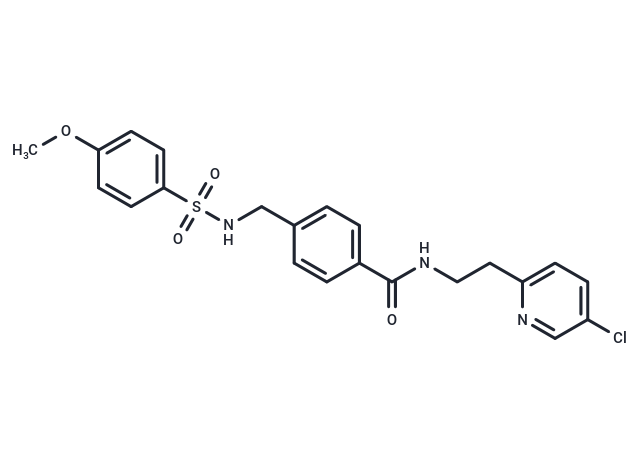Shopping Cart
- Remove All
 Your shopping cart is currently empty
Your shopping cart is currently empty

YU238259 is a novel inhibitor of homology-dependent DNA repair(HDR), but does not inhibit non-homologous end-joining (NHEJ), in cell-based GFP reporter assays.

| Pack Size | Price | Availability | Quantity |
|---|---|---|---|
| 1 mg | $40 | In Stock | |
| 2 mg | $57 | In Stock | |
| 5 mg | $89 | In Stock | |
| 10 mg | $155 | In Stock | |
| 25 mg | $322 | In Stock | |
| 50 mg | $572 | In Stock | |
| 100 mg | $822 | In Stock | |
| 500 mg | $1,690 | In Stock | |
| 1 mL x 10 mM (in DMSO) | $89 | In Stock |
| Description | YU238259 is a novel inhibitor of homology-dependent DNA repair(HDR), but does not inhibit non-homologous end-joining (NHEJ), in cell-based GFP reporter assays. |
| In vitro | YU238259 sensitizes tumor cells to radiation therapy and DSB-inducing chemotherapy. Treatment with YU238259 is not only synergistic with ionizing radiation (IR), etoposide, and PARP inhibition, but this synergism is heightened by BRCA2-deficiency. Synthetic lethality of YU238259 in HDR-deficient cells results from accumulation of unresolved DSBs following additional inhibition of residual HDR pathway activity. Inhibition of HDR activity by YU238259 has little to no effect on the NHEJ pathway. |
| In vivo | Growth of BRCA2-deficient human tumor xenografts in nude mice is significantly delayed by YU238259 treatment even without concomitant DNA-damaging therapy. |
| Kinase Assay | The cloning, expression and purification of USP21 from BL21 (DE3) bacteria are performed using standard molecular biology techniques. USP2, USP5, USP7, USP8, USP28, USP47, Ub-PLA2 (Ub-CHOP) and Ub-EKL (Ub-CHOP2) are generated. Caspase 3 and the caspase 3 substrate DEVD-Rh110 are used. Deubiquitylating enzyme, cathepsin B and 20S proteasome chymotrypsin like protease activities are measured. Caspase 3 activity is determined using a similar protocol. Briefly, dose ranges of compound (including USP7/USP47 inhibitor) are incubated with caspase 3 for 30 minutes before the addition of DEVD-Rh110 and reading on a fluorometric plate reader using excitation and emission maxima of 485 nm and 531 nm respectively. The final concentrations of caspase 3 and DEVD-Rh110 are 2 nM and 100 nM respectively |
| Cell Research | U2OS cells were pretreated with 25 μM YU238259 or DMSO vehicle for 1 h and cells were then irradiated with 10 Gy IR. Cells were fixed at 8 h post-IR, stained with antibodies and Hoechst dye, and imaged. Foci were quantified using the InCell Analyzer algorithm developed by YCMD. Cells were scored as foci-positive if they contained ≥15 foci (BRCA1, pDNA-PK) or ≥20 foci (53BP1). |
| Animal Research | Animal Models: 069(nu)/070(nu/+) athymic nude mice. Formulation: 3:1 DMSO:PBS. Dosages: 3 mg/kg . Administration: i.p |
| Molecular Weight | 459.95 |
| Formula | C22H22ClN3O4S |
| Cas No. | 1943733-16-1 |
| Smiles | COc1ccc(cc1)S(=O)(=O)NCc1ccc(cc1)C(=O)NCCc1ccc(Cl)cn1 |
| Relative Density. | 1.323 g/cm3 (Predicted) |
| Storage | Powder: -20°C for 3 years | In solvent: -80°C for 1 year | Shipping with blue ice. | |||||||||||||||||||||||||||||||||||
| Solubility Information | Ethanol: < 1 mg/mL (insoluble or slightly soluble) DMSO: 84 mg/mL (182.63 mM), Sonication is recommended. H2O: < 1 mg/mL (insoluble or slightly soluble) | |||||||||||||||||||||||||||||||||||
Solution Preparation Table | ||||||||||||||||||||||||||||||||||||
DMSO
| ||||||||||||||||||||||||||||||||||||

Copyright © 2015-2025 TargetMol Chemicals Inc. All Rights Reserved.